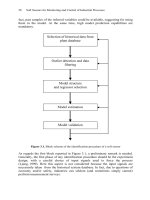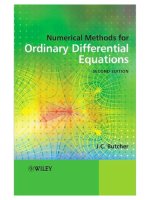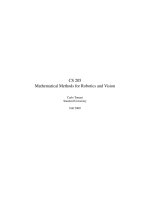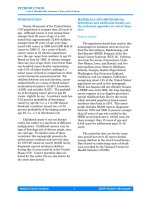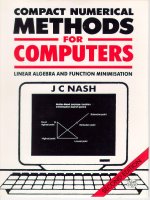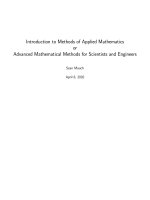Springer verlag numerical methods for elliptic and parabolic partial differential equations ebook KB
Bạn đang xem bản rút gọn của tài liệu. Xem và tải ngay bản đầy đủ của tài liệu tại đây (8.75 MB, 441 trang )
Numerical Methods for
Elliptic and Parabolic
Partial Differential
Equations
Peter Knabner
Lutz Angermann
Springer
Texts in Applied Mathematics
44
Editors
J.E. Marsden
L. Sirovich
S.S. Antman
Advisors
G. Iooss
P. Holmes
D. Barkley
M. Dellnitz
P. Newton
This page intentionally left blank
Peter Knabner
Lutz Angermann
Numerical Methods for
Elliptic and Parabolic Partial
Differential Equations
With 67 Figures
Peter Knabner
Institute for Applied Mathematics
University of Erlangen
Martensstrasse 3
D-91058 Erlangen
Germany
Lutz Angermann
Institute for Mathematics
University of Clausthal
Erzstrasse 1
D-38678 Clausthal-Zellerfeld
Germany
Series Editors
J.E. Marsden
Control and Dynamical Systems, 107–81
California Institute of Technology
Pasadena, CA 91125
USA
L. Sirovich
Division of Applied Mathematics
Brown University
Providence, RI 02912
USA
S.S. Antman
Department of Mathematics
and
Institute for Physical Science
and Technology
University of Maryland
College Park, MD 20742-4015
USA
Mathematics Subject Classification (2000): 65Nxx, 65Mxx, 65F10, 65H10
Library of Congress Cataloging-in-Publication Data
Knabner, Peter.
[Numerik partieller Differentialgleichungen. English]
Numerical methods for elliptic and parabolic partial differential equations /
Peter Knabner, Lutz Angermann.
p. cm. — (Texts in applied mathematics ; 44)
Include bibliographical references and index.
ISBN 0-387-95449-X (alk. paper)
1. Differential equations, Partial—Numerical solutions. I. Angermann, Lutz. II. Title.
III. Series.
QA377.K575 2003
515′.353—dc21
2002044522
ISBN 0-387-95449-X
Printed on acid-free paper.
2003 Springer-Verlag New York, Inc.
All rights reserved. This work may not be translated or copied in whole or in part without the written
permission of the publisher (Springer-Verlag New York, Inc., 175 Fifth Avenue, New York, NY 10010,
USA), except for brief excerpts in connection with reviews or scholarly analysis. Use in connection with
any form of information storage and retrieval, electronic adaptation, computer software, or by similar or
dissimilar methodology now known or hereafter developed is forbidden.
The use in this publication of trade names, trademarks, service marks, and similar terms, even if they are
not identified as such, is not to be taken as an expression of opinion as to whether or not they are subject
to proprietary rights.
Printed in the United States of America.
9 8 7 6 5 4 3 2 1
SPIN 10867187
Typesetting: Pages created by the authors in
2e using Springer’s svsing6.cls macro.
www.springer-ny.com
Springer-Verlag New York Berlin Heidelberg
A member of BertelsmannSpringer Science+Business Media GmbH
Series Preface
Mathematics is playing an ever more important role in the physical and
biological sciences, provoking a blurring of boundaries between scientific
disciplines and a resurgence of interest in the modern as well as the classical
techniques of applied mathematics. This renewal of interest, both in research and teaching, has led to the establishment of the series Texts in
Applied Mathematics (TAM).
The development of new courses is a natural consequence of a high level
of excitement on the research frontier as newer techniques, such as numerical and symbolic computer systems, dynamical systems, and chaos, mix
with and reinforce the traditional methods of applied mathematics. Thus,
the purpose of this textbook series is to meet the current and future needs
of these advances and to encourage the teaching of new courses.
TAM will publish textbooks suitable for use in advanced undergraduate
and beginning graduate courses, and will complement the Applied Mathematical Sciences (AMS) series, which will focus on advanced textbooks and
research-level monographs.
Pasadena, California
Providence, Rhode Island
College Park, Maryland
J.E. Marsden
L. Sirovich
S.S. Antman
This page intentionally left blank
Preface to the English Edition
Shortly after the appearance of the German edition we were asked by
Springer to create an English version of our book, and we gratefully accepted. We took this opportunity not only to correct some misprints and
mistakes that have come to our knowledge1 but also to extend the text at
various places. This mainly concerns the role of the finite difference and
the finite volume methods, which have gained more attention by a slight
extension of Chapters 1 and 6 and by a considerable extension of Chapter
7. Time-dependent problems are now treated with all three approaches (finite differences, finite elements, and finite volumes), doing this in a uniform
way as far as possible. This also made a reordering of Chapters 6–8 necessary. Also, the index has been enlarged. To improve the direct usability
in courses, exercises now follow each section and should provide enough
material for homework.
This new version of the book would not have come into existence without
our already mentioned team of helpers, who also carried out first versions
of translations of parts of the book. Beyond those already mentioned, the
team was enforced by Cecilia David, Basca Jadamba, Dr. Serge Krăautle,
Dr. Wilhelm Merz, and Peter Mirsch. Alexander Prechtel now took charge
of the difficult modification process. Prof. Paul DuChateau suggested improvements. We want to extend our gratitude to all of them. Finally, we
1 Users of the German edition may consult
/>
viii
Preface to the English Edition
thank senior editor Achi Dosanjh, from Springer-Verlag New York, Inc., for
her constant encouragement.
Remarks for the Reader and the Use in Lectures
The size of the text corresponds roughly to four hours of lectures per week
over two terms. If the course lasts only one term, then a selection is necessary, which should be orientated to the audience. We recommend the
following “cuts”:
Chapter 0 may be skipped if the partial differential equations treated
therein are familiar. Section 0.5 should be consulted because of the notation
collected there. The same is true for Chapter 1; possibly Section 1.4 may
be integrated into Chapter 3 if one wants to deal with Section 3.9 or with
Section 7.5.
Chapters 2 and 3 are the core of the book. The inductive presentation that we preferred for some theoretical aspects may be shortened for
students of mathematics. To the lecturer’s taste and depending on the
knowledge of the audience in numerical mathematics Section 2.5 may be
skipped. This might impede the treatment of the ILU preconditioning in
Section 5.3. Observe that in Sections 2.1–2.3 the treatment of the model
problem is merged with basic abstract statements. Skipping the treatment
of the model problem, in turn, requires an integration of these statements
into Chapter 3. In doing so Section 2.4 may be easily combined with Section 3.5. In Chapter 3 the theoretical kernel consists of Sections 3.1, 3.2.1,
3.3–3.4.
Chapter 4 presents an overview of its subject, not a detailed development,
and is an extension of the classical subjects, as are Chapters 6 and 9 and
the related parts of Chapter 7.
In the extensive Chapter 5 one might focus on special subjects or just consider Sections 5.2, 5.3 (and 5.4) in order to present at least one practically
relevant and modern iterative method.
Section 8.1 and the first part of Section 8.2 contain basic knowledge of
numerical mathematics and, depending on the audience, may be omitted.
The appendices are meant only for consultation and may complete
the basic lectures, such as in analysis, linear algebra, and advanced
mathematics for engineers.
Concerning related textbooks for supplementary use, to the best of our
knowledge there is none covering approximately the same topics. Quite a
few deal with finite element methods, and the closest one in spirit probably
is [21], but also [6] or [7] have a certain overlap, and also offer additional
material not covered here. From the books specialised in finite difference
methods, we mention [32] as an example. The (node-oriented) finite volume
method is popular in engineering, in particular in fluid dynamics, but to
the best of our knowledge there is no presentation similar to ours in a
Preface to the English Edition
ix
mathematical textbook. References to textbooks specialised in the topics
of Chapters 4, 5 and 8 are given there.
Remarks on the Notation
Printing in italics emphasizes definitions of notation, even if this is not
carried out as a numbered definition.
Vectors appear in different forms: Besides the “short” space vectors
x ∈ Rd there are “long” representation vectors u ∈ Rm , which describe
in general the degrees of freedom of a finite element (or volume) approximation or represent the values on grid points of a finite difference method.
Here we choose bold type, also in order to have a distinctive feature from
the generated functions, which frequently have the same notation, or from
the grid functions.
Deviations can be found in Chapter 0, where vectorial quantities belonging to Rd are boldly typed, and in Chapters 5 and 8, where the unknowns
of linear and nonlinear systems of equations, which are treated in a general
manner there, are denoted by x ∈ Rm .
Components of vectors will be designated by a subindex, creating a
double index for indexed quantities. Sequences of vectors will be supplied
with a superindex (in parentheses); only in an abstract setting do we use
subindices.
Erlangen, Germany
Clausthal-Zellerfeld, Germany
January 2002
Peter Knabner
Lutz Angermann
This page intentionally left blank
Preface to the German Edition
This book resulted from lectures given at the University of Erlangen–
Nuremberg and at the University of Magdeburg. On these occasions we
often had to deal with the problem of a heterogeneous audience composed
of students of mathematics and of different natural or engineering sciences.
Thus the expectations of the students concerning the mathematical accuracy and the applicability of the results were widely spread. On the other
hand, neither relevant models of partial differential equations nor some
knowledge of the (modern) theory of partial differential equations could be
assumed among the whole audience. Consequently, in order to overcome the
given situation, we have chosen a selection of models and methods relevant
for applications (which might be extended) and attempted to illuminate the
whole spectrum, extending from the theory to the implementation, without assuming advanced mathematical background. Most of the theoretical
obstacles, difficult for nonmathematicians, will be treated in an “inductive” manner. In general, we use an explanatory style without (hopefully)
compromising the mathematical accuracy.
We hope to supply especially students of mathematics with the information necessary for the comprehension and implementation of finite
element/finite volume methods. For students of the various natural or
engineering sciences the text offers, beyond the possibly already existing
knowledge concerning the application of the methods in special fields, an
introduction into the mathematical foundations, which should facilitate the
transformation of specific knowledge to other fields of applications.
We want to express our gratitude for the valuable help that we received
during the writing of this book: Dr. Markus Bause, Sandro Bitterlich,
xii
Preface to the German Edition
Dr. Christof Eck, Alexander Prechtel, Joachim Rang, and Dr. Eckhard
Schneid did the proofreading and suggested important improvements. From
the anonymous referees we received useful comments. Very special thanks
go to Mrs. Magdalena Ihle and Dr. Gerhard Summ. Mrs. Ihle transposed
the text quickly and precisely into TEX. Dr. Summ not only worked on the
original script and on the TEX-form, he also organized the complex and
distributed rewriting and extension procedure. The elimination of many
inconsistencies is due to him. Additionally he influenced parts of Sections 3.4 and 3.8 by his outstanding diploma thesis. We also want to thank
Dr. Chistoph Tapp for the preparation of the graphic of the title and for
providing other graphics from his doctoral thesis [70].
Of course, hints concerning (typing) mistakes and general improvements
are always welcome.
We thank Springer-Verlag for their constructive collaboration.
Last, but not least, we want to express our gratitude to our families for
their understanding and forbearance, which were necessary for us especially
during the last months of writing.
Erlangen, Germany
Magdeburg, Germany
February 2000
Peter Knabner
Lutz Angermann
Contents
Series Preface
v
Preface to the English Edition
vii
Preface to the German Edition
xi
0 For Example: Modelling Processes in Porous Media
with Differential Equations
0.1
The Basic Partial Differential Equation Models . . .
0.2
Reactions and Transport in Porous Media . . . . . .
0.3
Fluid Flow in Porous Media . . . . . . . . . . . . . .
0.4
Reactive Solute Transport in Porous Media . . . . . .
0.5
Boundary and Initial Value Problems . . . . . . . . .
.
.
.
.
.
1
1
5
7
11
14
. . .
. . .
19
19
21
. . .
. . .
29
36
2 The Finite Element Method for the Poisson Equation
2.1
Variational Formulation for the Model Problem . . . . .
46
46
1 For the Beginning: The Finite Difference Method
for the Poisson Equation
1.1
The Dirichlet Problem for the Poisson Equation . .
1.2
The Finite Difference Method . . . . . . . . . . . .
1.3
Generalizations and Limitations
of the Finite Difference Method . . . . . . . . . . .
1.4
Maximum Principles and Stability . . . . . . . . . .
.
.
.
.
.
xiv
Contents
2.2
2.3
2.4
2.5
The Finite Element Method with Linear Elements .
Stability and Convergence of the
Finite Element Method . . . . . . . . . . . . . . . .
The Implementation of the Finite Element Method:
Part 1 . . . . . . . . . . . . . . . . . . . . . . . . .
Solving Sparse Systems of Linear Equations
by Direct Methods . . . . . . . . . . . . . . . . . .
. . .
55
. . .
68
. . .
74
. . .
82
3 The Finite Element Method for Linear Elliptic
Boundary Value Problems of Second Order
3.1
Variational Equations and Sobolev Spaces . . . . . .
3.2
Elliptic Boundary Value Problems of Second Order .
3.3
Element Types and Affine
Equivalent Triangulations . . . . . . . . . . . . . . .
3.4
Convergence Rate Estimates . . . . . . . . . . . . . .
3.5
The Implementation of the Finite Element Method:
Part 2 . . . . . . . . . . . . . . . . . . . . . . . . . .
3.6
Convergence Rate Results in Case of
Quadrature and Interpolation . . . . . . . . . . . . .
3.7
The Condition Number of Finite Element Matrices .
3.8
General Domains and Isoparametric Elements . . . .
3.9
The Maximum Principle for Finite Element Methods
. .
. .
92
92
100
. .
. .
114
131
. .
148
.
.
.
.
.
.
.
.
155
163
167
171
4 Grid Generation and A Posteriori Error Estimation
4.1
Grid Generation . . . . . . . . . . . . . . . . . . . . . . .
4.2
A Posteriori Error Estimates and Grid Adaptation . . .
176
176
185
5 Iterative Methods for Systems of Linear Equations
5.1
Linear Stationary Iterative Methods . . . . . . . . .
5.2
Gradient and Conjugate Gradient Methods . . . . .
5.3
Preconditioned Conjugate Gradient Method . . . .
5.4
Krylov Subspace Methods
for Nonsymmetric Systems of Equations . . . . . .
5.5
The Multigrid Method . . . . . . . . . . . . . . . .
5.6
Nested Iterations . . . . . . . . . . . . . . . . . . .
. . .
. . .
. . .
198
200
217
227
. . .
. . .
. . .
233
238
251
6 The Finite Volume Method
6.1
The Basic Idea of the Finite Volume Method . . . . . . .
6.2
The Finite Volume Method for Linear Elliptic Differential Equations of Second Order on Triangular Grids . . .
255
256
7 Discretization Methods for Parabolic Initial Boundary
Value Problems
7.1
Problem Setting and Solution Concept . . . . . . . . . .
7.2
Semidiscretization by the Vertical Method of Lines . . .
262
283
283
293
Contents
xv
. . . . . . . . . . . . . .
. . . . . . . . . . . . . .
311
315
. . . . . . . . . . . . . .
. . . . . . . . . . . . . .
323
330
8 Iterative Methods for Nonlinear Equations
8.1
Fixed-Point Iterations . . . . . . . . . . . . . . . . . . . .
8.2
Newton’s Method and Its Variants . . . . . . . . . . . .
8.3
Semilinear Boundary Value Problems for Elliptic
and Parabolic Equations . . . . . . . . . . . . . . . . . .
342
344
348
7.3
7.4
7.5
7.6
Fully Discrete Schemes . . . . .
Stability . . . . . . . . . . . . .
The Maximum Principle for the
One-Step-Theta Method . . . .
Order of Convergence Estimates
9 Discretization Methods
for Convection-Dominated Problems
9.1
Standard Methods and
Convection-Dominated Problems .
9.2
The Streamline-Diffusion Method .
9.3
Finite Volume Methods . . . . . . .
9.4
The Lagrange–Galerkin Method . .
360
368
.
.
.
.
.
.
.
.
.
.
.
.
.
.
.
.
A Appendices
A.1 Notation . . . . . . . . . . . . . . . . . . .
A.2 Basic Concepts of Analysis . . . . . . . . .
A.3 Basic Concepts of Linear Algebra . . . . .
A.4 Some Definitions and Arguments of Linear
Functional Analysis . . . . . . . . . . . . .
A.5 Function Spaces . . . . . . . . . . . . . . .
.
.
.
.
.
.
.
.
.
.
.
.
.
.
.
.
.
.
.
.
.
.
.
.
.
.
.
.
.
.
.
.
368
375
383
387
. . . . . . . .
. . . . . . . .
. . . . . . . .
390
390
393
394
. . . . . . . .
. . . . . . . .
399
404
References: Textbooks and Monographs
409
References: Journal Papers
412
Index
415
This page intentionally left blank
0
For Example:
Modelling Processes in Porous
Media with Differential Equations
This chapter illustrates the scientific context in which differential equation
models may occur, in general, and also in a specific example. Section 0.1
reviews the fundamental equations, for some of them discretization techniques will be developed and investigated in this book. In Sections 0.2 –
0.4 we focus on reaction and transport processes in porous media. These
sections are independent of the remaining parts and may be skipped by
the reader. Section 0.5, however, should be consulted because it fixes some
notation to be used later on.
0.1 The Basic Partial Differential Equation Models
Partial differential equations are equations involving some partial derivatives of an unknown function u in several independent variables. Partial
differential equations which arise from the modelling of spatial (and temporal) processes in nature or technology are of particular interest. Therefore,
we assume that the variables of u are x = (x1 , . . . , xd )T ∈ Rd for d ≥ 1,
representing a spatial point, and possibly t ∈ R, representing time. Thus
the minimal set of variables is (x1 , x2 ) or (x1 , t), otherwise we have ordinary
differential equations. We will assume that x ∈ Ω, where Ω is a bounded
domain, e.g., a metal workpiece, or a groundwater aquifer, and t ∈ (0, T ] for
some (time horizon) T > 0. Nevertheless also processes acting in the whole
Rd × R, or in unbounded subsets of it, are of interest. One may consult the
Appendix for notations from analysis etc. used here. Often the function u
2
0. Modelling Processes in Porous Media with Differential Equations
represents, or is related to, the volume density of an extensive quantity like
mass, energy, or momentum, which is conserved. In their original form all
quantities have dimensions that we denote in accordance with the International System of Units (SI) and write in square brackets [ ]. Let a be
a symbol for the unit of the extensive quantity, then its volume density
is assumed to have the form S = S(u), i.e., the unit of S(u) is a/m3 . For
example, for mass conservation a = kg, and S(u) is a concentration. For
describing the conservation we consider an arbitrary “not too bad” sub˜ ⊂ Ω, the control volume. The time variation of the total extensive
set Ω
˜ is then
quantity in Ω
∂t
S(u(x, t))dx .
(0.1)
˜
Ω
If this function does not vanish, only two reasons are possible due to conservation:
— There is an internally distributed source density Q = Q(x, t, u) [a/m3 /s],
being positive if S(u) is produced, and negative if it is destroyed, i.e., one
term to balance (0.1) is Ω˜ Q(x, t, u(x, t))dx.
˜ of
— There is a net flux of the extensive quantity over the boundary ∂ Ω
2
˜
Ω. Let J = J (x, t) [a/m /s] denote the flux density, i.e., J i is the amount,
that passes a unit square perpendicular to the ith axis in one second in
the direction of the ith axis (if positive), and in the opposite direction
otherwise. Then another term to balance (0.1) is given by
−
J (x, t) · ν(x)dσ ,
∂Ω
where ν denotes the outer unit normal on ∂Ω. Summarizing the conservation reads
S(u(x, t))dx = −
∂t
˜
Ω
J (x, t) · ν(x)dσ +
˜
∂Ω
Q(x, t, u(x, t))dx .
(0.2)
˜
Ω
The integral theorem of Gauss (see (2.3)) and an exchange of time
derivative and integral leads to
[∂t S(u(x, t)) + ∇ · J (x, t) − Q(x, t, u(x, t))]dx = 0 ,
˜
Ω
˜ is arbitrary, also to
and, as Ω
∂t S(u(x, t)) + ∇ · J(x, t) = Q(x, t, u(x, t)) for x ∈ Ω, t ∈ (0, T ] .
(0.3)
All manipulations here are formal assuming that the functions involved
have the necessary properties. The partial differential equation (0.3) is the
basic pointwise conservation equation, (0.2) its corresponding integral form.
Equation (0.3) is one requirement for the two unknowns u and J , thus it
0.1. The Basic Partial Differential Equation Models
3
has to be closed by a (phenomenological) constitutive law, postulating a
relation between J and u.
Assume Ω is a container filled with a fluid in which a substance is dissolved. If u is the concentration of this substance, then S(u) = u and a
= kg. The description of J depends on the processes involved. If the fluid
is at rest, then flux is only possible due to molecular diffusion, i.e., a flux
from high to low concentrations due to random motion of the dissolved
particles. Experimental evidence leads to
J (1) = −K∇u
(0.4)
with a parameter K > 0 [m /s], the molecular diffusivity. Equation (0.4)
is called Fick’s law.
In other situations, like heat conduction in a solid, a similar model occurs.
Here, u represents the temperature, and the underlying principle is energy
conservation. The constitutive law is Fourier’s law, which also has the form
(0.4), but as K is a material parameter, it may vary with space or, for
anisotropic materials, be a matrix instead of a scalar.
Thus we obtain the diffusion equation
2
∂t u − ∇ · (K∇u) = Q .
(0.5)
If K is scalar and constant — let K = 1 by scaling —, and f := Q is
independent of u, the equation simplifies further to
∂t u − ∆u = f ,
where ∆u := ∇·(∇u) . We mentioned already that this equation also occurs
in the modelling of heat conduction, therefore this equation or (0.5) is also
called the heat equation.
If the fluid is in motion with a (given) velocity c then (forced) convection
of the particles takes place, being described by
J (2) = uc ,
(0.6)
i.e., taking both processes into account, the model takes the form of the
convection-diffusion equation
∂t u − ∇ · (K∇u − cu) = Q .
(0.7)
The relative strength of the two processes is measured by the P´eclet
number (defined in Section 0.4). If convection is dominating one may ignore
diffusion and only consider the transport equation
∂t u + ∇ · (cu) = Q .
(0.8)
The different nature of the two processes has to be reflected in the models,
therefore, adapted discretization techniques will be necessary. In this book
we will consider models like (0.7), usually with a significant contribution
of diffusion, and the case of dominating convection is studied in Chapter
9. The pure convective case like (0.8) will not be treated.
4
0. Modelling Processes in Porous Media with Differential Equations
In more general versions of (0.7) ∂t u is replaced by ∂t S(u), where S
depends linearly or nonlinearly on u. In the case of heat conduction S is
the internal energy density, which is related to the temperature u via the
factors mass density and specific heat. For some materials the specific heat
depends on the temperature, then S is a nonlinear function of u.
Further aspects come into play by the source term Q if it depends linearly
or nonlinearly on u, in particular due to (chemical) reactions. Examples for
these cases will be developed in the following sections. Since equation (0.3)
and its examples describe conservation in general, it still has to be adapted
to a concrete situation to ensure a unique solution u. This is done by the
specification of an initial condition
for x ∈ Ω ,
S(u(x, 0)) = S0 (x)
and by boundary conditions. In the example of the water filled container
no mass flux will occur across its walls, therefore, the following boundary
condition
J · ν(x, t) = 0 for x ∈ ∂Ω, t ∈ (0, T )
(0.9)
is appropriate, which — depending on the definition of J — prescribes the
normal derivative of u, or a linear combination of it and u. In Section 0.5
additional situations are depicted.
If a process is stationary, i.e. time-independent, then equation (0.3)
reduces to
∇ · J (x) = Q(x, u(x))
for x ∈ Ω ,
which in the case of diffusion and convection is specified to
−∇ · (K∇u − cu) = Q .
For constant K — let K = 1 by scaling —, c = 0, and f := Q, being
independent of u, this equation reduces to
−∆u = f
in Ω ,
the Poisson equation.
Instead of the boundary condition (0.9), one can prescribe the values of
the function u at the boundary:
u(x) = g(x)
for x ∈ ∂Ω .
For models , where u is a concentration or temperature, the physical realisation of such a boundary condition may raise questions, but in mechanical
models, where u is to interpreted as a displacement, such a boundary condition seems reasonable. The last boundary value problem will be the first
model, whose discretization will be discussed in Chapters 1 and 2.
Finally it should be noted that it is advisable to non-dimensionalise the
final model before numerical methods are applied. This means that both
the independent variables xi (and t), and the dependent one u, are replaced
0.2. Reactions and Transport in Porous Media
5
by xi /xi,ref , t/tref , and u/uref , where xi,ref , tref , and uref are fixed reference
values of the same dimension as xi , t, and u, respectively. These reference
values are considered to be of typical size for the problems under investigation. This procedure has two advantages: On the one hand, the typical size
is now 1, such that there is an absolute scale for (an error in) a quantity
to be small or large. On the other hand, if the reference values are chosen
appropriately a reduction in the number of equation parameters like K
and c in (0.7) might be possible, having only fewer algebraic expressions of
the original material parameters in the equation. This facilitates numerical
parameter studies.
0.2 Reactions and Transport in Porous Media
A porous medium is a heterogeneous material consisting of a solid matrix
and a pore space contained therein. We consider the pore space (of the
porous medium) as connected; otherwise, the transport of fluids in the
pore space would not be possible. Porous media occur in nature and manufactured materials. Soils and aquifers are examples in geosciences; porous
catalysts, chromatographic columns, and ceramic foams play important
roles in chemical engineering. Even the human skin can be considered a
porous medium. In the following we focus on applications in the geosciences.
Thus we use a terminology referring to the natural soil as a porous medium.
On the micro or pore scale of a single grain or pore, i.e., in a range of µm
to mm, the fluids constitute different phases in the thermodynamic sense.
Thus we name this system in the case of k fluids including the solid matrix
as (k + 1)-phase system or we speak of k-phase flow.
We distinguish three classes of fluids with different affinities to the solid
matrix. These are an aqueous phase, marked with the index “w” for water,
a nonaqueous phase liquid (like oil or gasoline as natural resources or contaminants), marked with the index “o,” and a gaseous phase, marked with
the index “g” (e.g., soil air). Locally, at least one of these phases has always to be present; during a transient process phases can locally disappear
or be generated. These fluid phases are in turn mixtures of several components. In applications of the earth sciences, for example, we do not deal
with pure water but encounter different species in true or colloidal solution in the solvent water. The wide range of chemical components includes
plant nutrients, mineral nutrients from salt domes, organic decomposition
products, and various organic and inorganic chemicals. These substances
are normally not inert, but are subject to reactions and transformation
processes. Along with diffusion, forced convection induced by the motion
of the fluid is the essential driving mechanism for the transport of solutes.
But we also encounter natural convection by the coupling of the dynamics
of the substance to the fluid flow. The description level at the microscale
6
0. Modelling Processes in Porous Media with Differential Equations
that we have used so far is not suitable for processes at the laboratory or
technical scale, which take place in ranges of cm to m, or even for processes
in a catchment area with units of km. For those macroscales new models
have to be developed, which emerge from averaging procedures of the models on the microscale. There may also exist principal differences among the
various macroscales that let us expect different models, which arise from
each other by upscaling. But this aspect will not be investigated here further. For the transition of micro to macro scales the engineering sciences
provide the heuristic method of volume averaging, and mathematics the
rigorous (but of only limited use) approach of homogenization (see [36] or
[19]). None of the two possibilities can be depicted here completely. Where
necessary we will refer to volume averaging for (heuristic) motivation.
Let Ω ⊂ Rd be the domain of interest. All subsequent considerations are
formal in the sense that the admissibility of the analytic manipulations is
supposed. This can be achieved by the assumption of sufficient smoothness
for the corresponding functions and domains.
Let V ⊂ Ω be an admissible representative elementary volume in the
sense of volume averaging around a point x ∈ Ω. Typically the shape and
the size of a representative elementary volume are selected in such a manner
that the averaged values of all geometric characteristics of the microstructure of the pore space are independent of the size of V but depend on
the location of the point x. Then we obtain for a given variable ωα in the
phase α (after continuation of ωα with 0 outside of α) the corresponding
macroscopic quantities, assigned to the location x, as the extrinsic phase
average
ωα :=
1
|V |
ωα
V
or as the intrinsic phase average
ωα
α
:=
1
|Vα |
ωα .
Vα
Here Vα denotes the subset of V corresponding to α. Let t ∈ (0, T ) be
the time at which the process is observed. The notation x ∈ Ω means the
vector in Cartesian coordinates, whose coordinates are referred to by x,
y, and z ∈ R. Despite this ambiguity the meaning can always be clearly
derived from the context.
Let the index “s” (for solid) stand for the solid phase; then
φ(x) := |V \ Vs |
|V | > 0
denotes the porosity, and for every liquid phase α,
Sα (x, t) := |Vα |
|V \ Vs | ≥ 0
0.3. Fluid Flow in Porous Media
7
is the saturation of the phase α. Here we suppose that the solid phase is
stable and immobile. Thus
ωα = φSα ωα
α
for a fluid phase α and
Sα = 1 .
(0.10)
α:fluid
So if the fluid phases are immiscible on the micro scale, they may be miscible
on the macro scale, and the immiscibility on the macro scale is an additional
assumption for the model.
As in other disciplines the differential equation models are derived here
from conservation laws for the extensive quantities mass, impulse, and energy, supplemented by constitutive relationships, where we want to focus
on the mass.
0.3 Fluid Flow in Porous Media
Consider a liquid phase α on the micro scale. In this chapter, for clarity, we
write “short” vectors in Rd also in bold with the exception of the coordinate
˜ η ˜α
vector x. Let ˜α [kg/m3 ] be the (microscopic) density, q˜ α :=
η ˜η v
˜ η of
[m/s] the mass average mixture velocity based on the particle velocity v
a component η and its concentration in solution ˜η [kg/m3 ]. The transport
theorem of Reynolds (see, for example, [10]) leads to the mass conservation
law
˜ α ) = f˜α
∂t ˜α + ∇ · (˜α q
(0.11)
with a distributed mass source density f˜α . By averaging we obtain from
here the mass conservation law
∂t (φSα
α)
+∇·(
αqα)
= fα
(0.12)
with α , the density of phase α, as the intrinsic phase average of ˜α and
q α , the volumetric fluid velocity or Darcy velocity of the phase α, as the
˜ α . Correspondingly, fα is an average mass source
extrinsic phase average of q
density.
Before we proceed in the general discussion, we want to consider some
specific situations: The area between the groundwater table and the impermeable body of an aquifer is characterized by the fact that the whole pore
space is occupied by a fluid phase, the soil water. The corresponding saturation thus equals 1 everywhere, and with omission of the index equation
(0.12) takes the form
∂t (φ ) + ∇ · ( q) = f .
(0.13)
8
0. Modelling Processes in Porous Media with Differential Equations
If the density of water is assumed to be constant, due to neglecting
the mass of solutes and compressibility of water, equation (0.13) simplifies
further to the stationary equation
∇·q =f ,
(0.14)
where f has been replaced by the volume source density f / , keeping the
same notation. This equation will be completed by a relationship that
can be interpreted as the macroscopic analogue of the conservation of momentum, but should be accounted here only as an experimentally derived
constitutive relationship. This relationship is called Darcy’s law, which
reads as
q = −K (∇p + gez )
(0.15)
and can be applied in the range of laminar flow. Here p [N/m2 ] is the intrinsic
average of the water pressure, g [m/s2 ] the gravitational acceleration, ez the
unit vector in the z-direction oriented against the gravitation,
K = k/µ ,
(0.16)
a quantity, which is given by the permeability k determined by the solid
phase, and the viscosity µ determined by the fluid phase. For an anisotropic
solid, the matrix k = k(x) is a symmetric positive definite matrix.
Inserting (0.15) in (0.14) and replacing K by K g, known as hydraulic
conductivity in the literature, and keeping the same notation gives the
following linear equation for
h(x, t) :=
1
p(x, t) + z ,
g
the piezometric head h [m]:
−∇ · (K∇h) = f .
(0.17)
The resulting equation is stationary and linear. We call a differential equation model stationary if it depends only on the location x and not on the
time t, and instationary otherwise. A differential equation and corresponding boundary conditions (cf. Section 0.5) are called linear if the sum or a
scalar multiple of a solution again forms a solution for the sum, respectively
the scalar multiple, of the sources.
If we deal with an isotropic solid matrix, we have K = KI with the d× d
unit matrix I and a scalar function K. Equation (0.17) in this case reads
−∇ · (K∇h) = f .
(0.18)
Finally if the solid matrix is homogeneous, i.e., K is constant, we get from
division by K and maintaining the notation f the Poisson equation
−∆h = f ,
(0.19)

